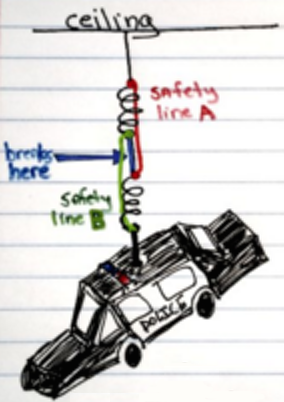It Seemed Like A Good Idea At The Time

The sketch above shows a police car suspended from the ceiling. The suspension system is two identical springs connected by a short length of rope.
After the springs have reached equilibrium, two safety lines are attached with no slack in them: one connecting the tops of the two springs and one connecting the bottoms of the two springs.
But the springs aren't the weakest link. It's the short length of rope between the two springs that snaps!
What happens when the rope between the two springs breaks?
My alma mater has a bit of an obsession with suspending cars from the ceiling.
This section requires Javascript.
You are seeing this because something didn't load right. We suggest you, (a) try
refreshing the page, (b) enabling javascript if it is disabled on your browser and,
finally, (c)
loading the
non-javascript version of this page
. We're sorry about the hassle.
The car moves up towards the ceiling and the springs aren't the weakest link